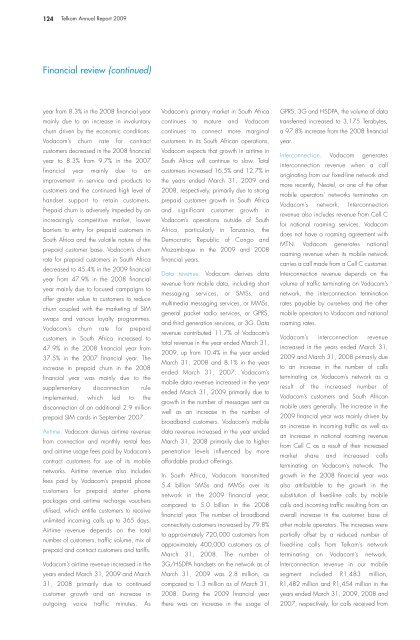Telkom AR front.qxp
Telkom AR front.qxp
Telkom AR front.qxp
Create successful ePaper yourself
Turn your PDF publications into a flip-book with our unique Google optimized e-Paper software.
124<br />
<strong>Telkom</strong> Annual Report 2009<br />
Financial review (continued)<br />
year from 8.3% in the 2008 financial year<br />
mainly due to an increase in involuntary<br />
churn driven by the economic conditions.<br />
Vodacom’s churn rate for contract<br />
customers decreased in the 2008 financial<br />
year to 8.3% from 9.7% in the 2007<br />
financial year mainly due to an<br />
improvement in service and products to<br />
customers and the continued high level of<br />
handset support to retain customers.<br />
Prepaid churn is adversely impeded by an<br />
increasingly competitive market, lower<br />
barriers to entry for prepaid customers in<br />
South Africa and the volatile nature of the<br />
prepaid customer base. Vodacom’s churn<br />
rate for prepaid customers in South Africa<br />
decreased to 45.4% in the 2009 financial<br />
year from 47.9% in the 2008 financial<br />
year mainly due to focused campaigns to<br />
offer greater value to customers to reduce<br />
churn coupled with the marketing of SIM<br />
swaps and various loyalty programmes.<br />
Vodacom’s churn rate for prepaid<br />
customers in South Africa increased to<br />
47.9% in the 2008 financial year from<br />
37.5% in the 2007 financial year. The<br />
increase in prepaid churn in the 2008<br />
financial year was mainly due to the<br />
supplementary disconnection rule<br />
implemented, which led to the<br />
disconnection of an additional 2.9 million<br />
prepaid SIM cards in September 2007.<br />
Airtime. Vodacom derives airtime revenue<br />
from connection and monthly rental fees<br />
and airtime usage fees paid by Vodacom’s<br />
contract customers for use of its mobile<br />
networks. Airtime revenue also includes<br />
fees paid by Vodacom’s prepaid phone<br />
customers for prepaid starter phone<br />
packages and airtime recharge vouchers<br />
utilised, which entitle customers to receive<br />
unlimited incoming calls up to 365 days.<br />
Airtime revenue depends on the total<br />
number of customers, traffic volume, mix of<br />
prepaid and contract customers and tariffs.<br />
Vodacom’s airtime revenue increased in the<br />
years ended March 31, 2009 and March<br />
31, 2008 primarily due to continued<br />
customer growth and an increase in<br />
outgoing voice traffic minutes. As<br />
Vodacom’s primary market in South Africa<br />
continues to mature and Vodacom<br />
continues to connect more marginal<br />
customers in its South African operations,<br />
Vodacom expects that growth in airtime in<br />
South Africa will continue to slow. Total<br />
customers increased 16.5% and 12.7% in<br />
the years ended March 31, 2009 and<br />
2008, respectively, primarily due to strong<br />
prepaid customer growth in South Africa<br />
and significant customer growth in<br />
Vodacom’s operations outside of South<br />
Africa, particularly in Tanzania, the<br />
Democratic Republic of Congo and<br />
Mozambique in the 2009 and 2008<br />
financial years.<br />
Data revenue. Vodacom derives data<br />
revenue from mobile data, including short<br />
messaging services, or SMSs, and<br />
multimedia messaging services, or MMSs,<br />
general packet radio services, or GPRS,<br />
and third generation services, or 3G. Data<br />
revenue contributed 11.7% of Vodacom’s<br />
total revenue in the year ended March 31,<br />
2009, up from 10.4% in the year ended<br />
March 31, 2008 and 8.1% in the year<br />
ended March 31, 2007. Vodacom’s<br />
mobile data revenue increased in the year<br />
ended March 31, 2009 primarily due to<br />
growth in the number of messages sent as<br />
well as an increase in the number of<br />
broadband customers. Vodacom’s mobile<br />
data revenue increased in the year ended<br />
March 31, 2008 primarily due to higher<br />
penetration levels influenced by more<br />
affordable product offerings.<br />
In South Africa, Vodacom transmitted<br />
5.4 billion SMSs and MMSs over its<br />
network in the 2009 financial year,<br />
compared to 5.0 billion in the 2008<br />
financial year. The number of broadband<br />
connectivity customers increased by 79.8%<br />
to approximately 720,000 customers from<br />
approximately 400,000 customers as of<br />
March 31, 2008. The number of<br />
3G/HSDPA handsets on the network as of<br />
March 31, 2009 was 2.8 million, as<br />
compared to 1.3 million as of March 31,<br />
2008. During the 2009 financial year<br />
there was an increase in the usage of<br />
GPRS, 3G and HSDPA, the volume of data<br />
transferred increased to 3,175 Terabytes,<br />
a 97.8% increase from the 2008 financial<br />
year.<br />
Interconnection. Vodacom generates<br />
interconnection revenue when a call<br />
originating from our fixed-line network and<br />
more recently, Neotel, or one of the other<br />
mobile operators’ networks terminates on<br />
Vodacom’s network. Interconnection<br />
revenue also includes revenue from Cell C<br />
for national roaming services. Vodacom<br />
does not have a roaming agreement with<br />
MTN. Vodacom generates national<br />
roaming revenue when its mobile network<br />
carries a call made from a Cell C customer.<br />
Interconnection revenue depends on the<br />
volume of traffic terminating on Vodacom’s<br />
network, the interconnection termination<br />
rates payable by ourselves and the other<br />
mobile operators to Vodacom and national<br />
roaming rates.<br />
Vodacom’s interconnection revenue<br />
increased in the years ended March 31,<br />
2009 and March 31, 2008 primarily due<br />
to an increase in the number of calls<br />
terminating on Vodacom’s network as a<br />
result of the increased number of<br />
Vodacom’s customers and South African<br />
mobile users generally. The increase in the<br />
2009 financial year was mainly driven by<br />
an increase in incoming traffic as well as<br />
an increase in national roaming revenue<br />
from Cell C as a result of their increased<br />
market share and increased calls<br />
terminating on Vodacom’s network. The<br />
growth in the 2008 financial year was<br />
also attributable to the growth in the<br />
substitution of fixed-line calls by mobile<br />
calls and incoming traffic resulting from an<br />
overall increase in the customer base of<br />
other mobile operators. The increases were<br />
partially offset by a reduced number of<br />
fixed-line calls from <strong>Telkom</strong>’s network<br />
terminating on Vodacom’s network.<br />
Interconnection revenue in our mobile<br />
segment included R1,483 million,<br />
R1,482 million and R1,454 million in the<br />
years ended March 31, 2009, 2008 and<br />
2007, respectively, for calls received from




